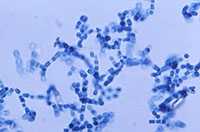Definition of Valley Fever (Coccidioidomycosis)

Photomicrograph showing arthroconidia of Coccidioides (environmental form)
Valley fever is an infection caused by the fungus Coccidioides. The scientific name for Valley fever is “coccidioidomycosis,” and it’s also sometimes called “San Joaquin Valley fever” or “desert rheumatism.” The term “Valley fever” usually refers to Coccidioides infection in the lungs, but the infection can spread to other parts of the body in severe cases (this is called “disseminated coccidioidomycosis”).
The fungus is known to live in the soil in the southwestern United States and parts of Mexico and Central and South America. The fungus was also recently found in south-central Washington. People can get Valley fever by breathing in the microscopic fungal spores from the air in these areas.
Most people who breathe in the spores don’t get sick, but some people do. Usually, people who get sick with Valley fever will get better on their own within weeks to months, but some people will need antifungal medication. Certain groups of people are at higher risk for developing the severe forms of the infection, and these people typically need antifungal treatment. It’s difficult to prevent exposure to Coccidioides in areas where it’s common in the environment, but people who are at higher risk for severe Valley fever should try to avoid breathing in large amounts of dust if they’re in these areas.
- Page last reviewed: January 27, 2017
- Page last updated: January 27, 2017
- Content source:


 ShareCompartir
ShareCompartir